Matador Network's Blog, page 475
May 18, 2022
11 Incredible Airbnb South Dakota Rentals To Explore the State

If the outdoor adventures of the Black Hills National Forest aren’t enough to entice you out to South Dakota, wait until you see the accommodation. The Airbnb South Dakota scene puts you right in the heart of the landscape and historic monuments. Keep scrolling for the best cabins and lodges with epic views and all the trimmings.
We hope you love the Airbnb South Dakota stays we recommend! Just so you know, Matador may collect a small commission from the links on this page if you decide to book a stay. Listed prices are accurate as of the time of publication.
Airbnbs in Sturgis, South DakotaAirbnbs in Deadwood, South DakotaAirbnbs in Rapid City, South DakotaAirbnbs in Sturgis, South DakotaSpacious Sturgis Retreat w/ Black Hills View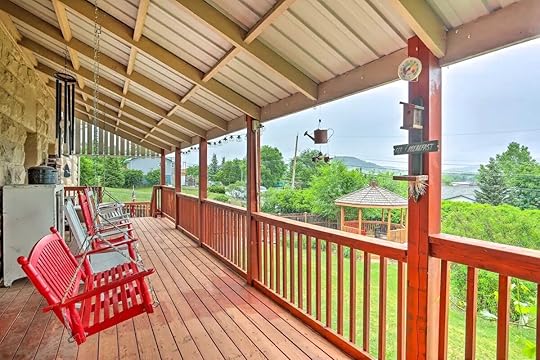
Photo: Airbnb

Photo: Airbnb

Photo: Airbnb

Photo: Airbnb
A newcomer to the market, this family-friendly Airbnb vacation rental is dressed with kooky furnishings and vintage-style appliances. Highlights include a piano and retro bathroom fixtures complete with a clawfoot tub in the “yellow” bathroom. The lower level bunk room shares space with a games zone. Besides the wraparound deck, the backyard comes with a wooden gazebo perfect for a pre-dinner drink. Mere moments from Main Street.
Fifteen guests, four bedrooms
Price: $300 per night

Photo: Airbnb
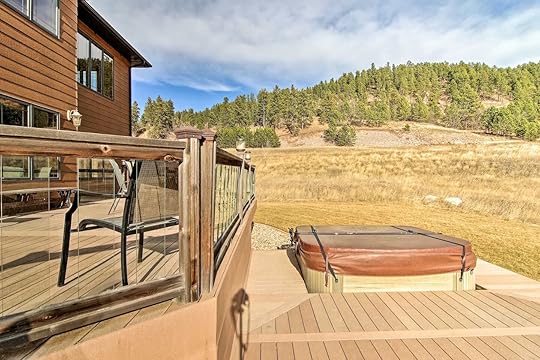
Photo: Airbnb

Photo: Airbnb

Photo: Airbnb
A short and sweet drive out of Sturgis, Summerlyn Villa is rigged with an outdoor hot tub, games room, wet bar, and jetted bathtub with garden views. Traveling with a tot in tow? This luxurious Airbnb in Sturgis, South Dakota, comes with a crib and high chair. Spanning a mighty 3,250 square feet of land, there’s more than enough space for a couple of families.
Sixteen guests, five bedrooms
Price: $760 per night

Photo: Airbnb
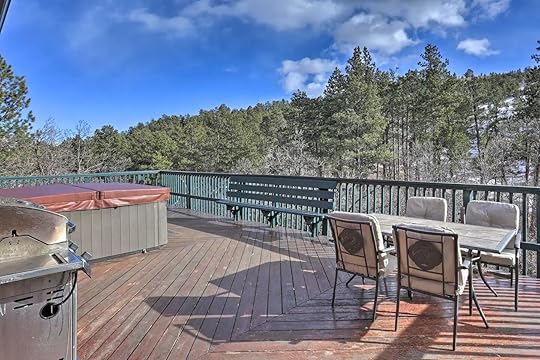
Photo: Airbnb

Photo: Airbnb

Photo: Airbnb
Another newbie, you can practically smell the fresh paint at this Airbnb cabin rental near Sturgis, South Dakota. The cabin is beautifully crafted from redwood and heated by a wood-burning stove. Peering over the surrounding woodlands, the deck is fitted with a hot tub and grill. Located on the outskirts of town, you’re a couple of miles from golf courses, hiking trails, and historic points of interest.
Fourteen guests, five bedrooms
Price: $220 per night

Photo: Airbnb
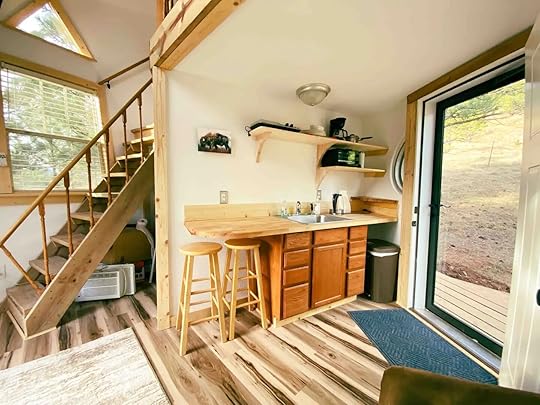
Photo: Airbnb
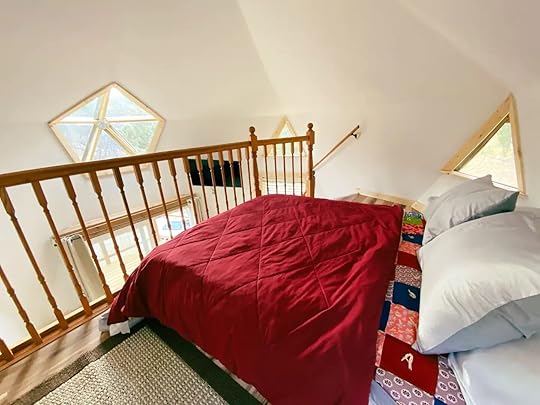
Photo: Airbnb

Photo: Airbnb
Is it a cabin, a tiny house, or a glamping yurt? It’s all three rolled into one! This unique Airbnb South Dakota geodesic dome presents a top-of-the-line glamping experience. Strategic windows provide views of the night sky from the mezzanine sleeping nook. Views from the elevated porch are unreal and lead you directly toward local hiking trails. Sustainably constructed without compromising on comfort, there’s no better place for a nature-loving duo.
Two guests, one bedroom
Price: $70 per night

Photo: Airbnb

Photo: Airbnb

Photo: Airbnb

Photo: Airbnb
This snazzy Airbnb Deadwood South Dakota is a premier luxury mountain home. Three levels cater to sociable groups with decadent lounges, a roomy dining area, and a games room. Despite the large space, the cabin retains a cozy energy with hygge-inspired fixtures. In addition to your private hot tub, rental grants access to the heated year-round pool at the Powder House Pass Clubhouse.
Sixteen guests, seven bedrooms
Price: $700 per night

Photo: Airbnb

Photo: Airbnb

Photo: Airbnb

Photo: Airbnb
Rejuvenate and create everlasting memories at this Airbnb South Dakota with a state-of-the-art hot tub and games room. Nifty use of balconies, the wraparound deck, and well-placed windows means that the space is flooded with light with great views over the canopy. Located a short drive from Deadwood, the chalet is a stone’s throw from the Terry Peak Ski area.
Thirteen guests, four bedrooms
Price: $550 per night

Photo: Airbnb

Photo: Airbnb

Photo: Airbnb
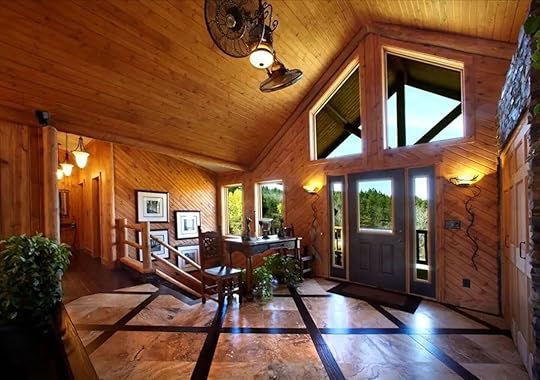
Photo: Airbnb
This atmospheric rental home sits on a clearing in the forest overlooking a small lake. Everything is super-sized: the lounge, the kitchen, the parking garage – there’s even a double shower. A hot tub with forest views, home cinema, and grill make this the perfect place to hole up for a sociable getaway. Furry friends are welcome at this pet-friendly Airbnb Deadwood South Dakota but you’ll need to give the host a head’s up at the time of booking. 
Fourteen guests, four bedrooms
Price: $480 per night

Photo: Airbnb

Photo: Airbnb

Photo: Airbnb

Photo: Airbnb
This sultry home with Black Hills views is the ultimate nest for a family or small group getaway. The interior is spearheaded by a sumptuous couch, ambient electric fireplace, and an eyeful of the ponderosa pines courtesy of the expansive living room windows. But of course, the cherry on top is the open-air hot tub on the private deck. Despite the overall feeling of remoteness, downtown Rapid City is a 10-minute drive away.
Two guests, one bedroom
Price: $350 per night

Photo: Airbnb

Photo: Airbnb

Photo: Airbnb

Photo: Airbnb
This pet-friendly Airbnb in South Dakota near Rapid City is cheerfully furnished in calming hues with a generously-proportioned open plan lounge and kitchen. Keep trim with the help of the basement gym and rally the clan for trivia night with the stack of games. A private hot tub is set up on the rear porch with a view over the lawn and vegetable patch – yes, you’re welcome to pick your own.
Nine guests, three bedrooms
Price: $1,090 per night
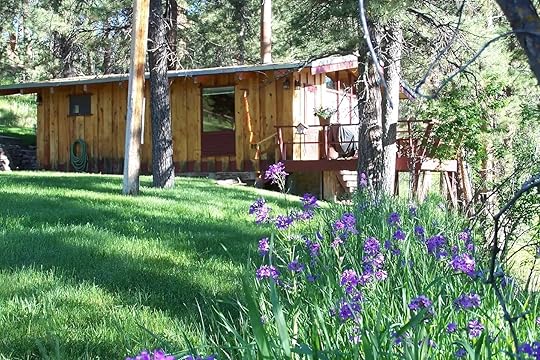
Photo: Airbnb

Photo: Airbnb

Photo: Airbnb

Photo: Airbnb
Although situated in the central Black Hills, this South Dakota Airbnb cabin rental is a short drive from Rapid City and Silver City. Bursting with rustic charisma, interiors consist of oak beams and a superb fireplace for snuggly nights in. Buried among ponderosa pines and overlooking the creek, the cabin feels completely off-grid. Deer, wild turkeys, and eagles are frequently spotted from the deck.
Two guests, one bedroom (studio)
Price: $200 per night

Photo: Airbnb

Photo: Airbnb

Photo: Airbnb

Photo: Airbnb
Located in the foothills of the Black Hills near Canyon Lake Park, this Airbnb in Rapid City, South Dakota, gives you the best of both worlds. The loft pad is fashionably appointed with a granite-topped kitchen and boutique furnishings. Besides the wistful breakfast balcony that overlooks the greenery, you’ll get access to a private patio with your own grill and dining area.
Two guests, one bedroom
Price: $100 per night
Sleep With Over 1 Million Bees on the First Bee Farm on Airbnb

We hope you love the spaces we recommend! Just so you know, Matador may collect a small commission from the links on this page if you decide to book a stay.
While bees may make some people uneasy thanks to their stingers, they’re some of the most important human allies worldwide. If you’d like to thank the little guys for all their hard work keeping everything pollinated, you can take advantage of a new Airbnb listing that lets you spend the night with the bees.
In honor of World Bee Day on May 20, an Italian beekeeper has made quite a buzz by opening up stays at an olive farm just outside of Grottole in southern Italy. Guests can now book a one-of-a-kind stay on the bee farm and be surrounded by one million working bees. Spend the night in a one-bedroom, one-bathroom honeycomb-shaped apiary designed by Davide Tagliabue and constructed by volunteers. Beekeeper Rocco will welcome guests to the farm and teach them how to live surrounded by bees.

Photo: Andrea Frazzetta / Airbnb
The nine beehives surrounding the space are separated using a net — meaning you can enjoy the beauty of the bees without letting them into your actual living space. While lying inside the structure, guests can enjoy the specially constructed box in the ceiling with a working hive, which offers awe-inspiring viewing of the bees as they rest. Guests can fall asleep to the soothing humming sound we all recognize. In the morning, guests can enjoy a buzzworthy breakfast of ricotta, strawberries, homemade biscuits, and, of course, local honey.
This stay is a completely rural experience that’s meant to reconnect you with nature. There is a private bathroom located in a nearby cottage and a shower located just outside, all powered by collection water. There’s no electricity, but there are LED lights that recharge in the sun and a cooler bag with fresh water.
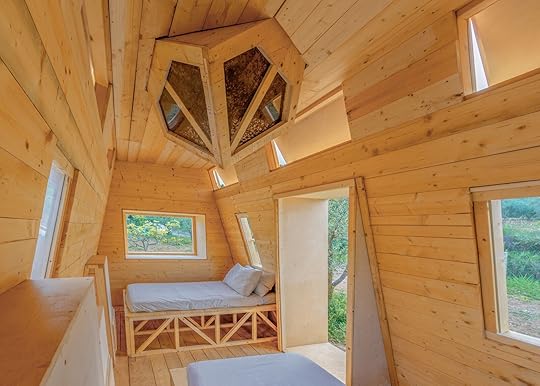
Photo: Sergio Manicone / Airbnb
If this sounds like the un-bee-lievable stay of your dreams, the bee farm is now available for booking. All proceeds from bookings will go to NGO Wonder Grottole’s bee conservation projects. 
The Best Michigan Beaches To See in the Upper Peninsula This Summer

Michigan has no shortage of beautiful beaches and the state’s rustic Upper Peninsula is no exception. From hidden sand dunes to forested lakeshores strewn with precious stones, the UP has it all. The peninsula separates Lake Michigan and Lake Huron from Lake Superior, the largest freshwater lake in the world.
On the Lake Michigan side, water temperatures often reach a comfortable 70 degrees from July to September. On the colder, deeper, and more northern coast of Lake Superior, the water barely tops 65 degrees in the summer. Most of the peninsula’s beaches offer fewer amenities than their counterparts in the lower mitten.
They are also more remote and challenging to find. However, the UP’s lakeshore is an example of how nature’s raw power and geologic history can create unparalleled beauty. When the weather is clear, the Upper Peninsula looks like the island-studded coast of Croatia; only remote, with the possibility of spotting black bears on the sand. For beach enthusiasts looking to get away, there is no better place on earth. These are the five best Upper Peninsula beaches to explore in Michigan this summer.
Sand Point Beach – Munising
Photo: RodClementPhotography/Shutterstock
Arguably Munising’s most popular beach, Sand Point deserves all its acclaim. This spot features stunning views of the Pictured Rocks formations, endless clear water, and sandbanks that run for several hundred feet. The beach has perfect yellow sand and naturally polished driftwood piled along the shores. As you take one of the small trails inland, you can experience the beautiful swamps and cattail groves that provide peaceful animal habitats. To top everything off, Sand Point’s sunsets over Grand Island’s East Channel Lighthouse are unforgettable.
Amenities: public restroom, nearby camping, pets allowed.
Miners Beach – Pictured Rocks National Lakeshore
Photo: Wildnerdpix/Shutterstock
People recognize Pictured Rocks National Lakeshore for its colorful cliff faces and the thick forests that hang precariously off of them. Sandwiched between the towering vermillion-colored rocks and turquoise water are some of the most scenic expanses of sand in the state. The most famous of these is Miner’s Beach. Along its shores is a superb hiking trail that takes you through white pine forests and past breathtaking views of the lake.
Here you look over jagged flat-topped rock formations that stand above the yellow sand and icy blue water. At the northern end of the beach is Elliot Falls, a small waterfall that flows over stratified layers of rock into the lake. Beachgoers can enjoy sunsets that famously encircle the offshore Grand Island in a kaleidoscope of colors. Between the natural landmarks, colorful shoreline, and coastal terrain, this is one of the most remarkable beaches in Michigan. Not to mention, it’s a top destination for kayakers.
Amenities: boardwalk, public restrooms, nearby camping, pets allowed.
Grand Sable Dunes – Grand Marais
\Photo: Dean Pennala/Shutterstock
Nothing represents Michigan’s nature more than sand dunes. Although the lower peninsula boasts the famous Sleeping Bear Dunes in Leelanau County, the UP has the comparably alluring and expansive Grand Sable Dunes. Just a short drive west of the rural fishing town of Grand Marais, the dunes cover a vast area and loom hundreds of feet over Lake Superior. Spectacular vistas spread out in almost all directions. For people looking for a physical challenge, running down the steep dune climb and exploring the wild lakeshore is a must.
Amenities: Public restroom, hiking trails, nearby camping, pets allowed.
Wetmore Landing Beach – Marquette
Photo: via Aaron Peterson and Travel Marquette
Marquette is a college town. Amazing breweries, restaurants, and cafes, often filled with students, pepper the city. It’s also a surf town. For lake surfers looking for waves of all levels, this is your place. Like any good surf zone, it has incredible beaches and a lively coastal vibe.
Wetmore beach is one of Marquette’s most beloved places for sand and clear water. Amazing natural scenery surrounds this remote and less visited area. A shoreline trail runs through the thick pine trees and maples and connects the main beach with another superb and hard-to-find section of sand known as Hidden Beach. The coastal scenery of rock formations and sweeping pines over Lake Superior’s wild azure waters are worthy of a magazine cover shot. For adventurous swimmers and snorkelers, off-shore rocks and caverns provide endless deep water fun.
Amenities: hiking trails, nearby camping, pets allowed.
Great Sand Bay Beach
Photo: via Keweenaw Peninsula
At the northern tip of Michigan, the Keweenaw Peninsula sticks out into the lake. The full force of Lake Superior’s storms march consistently into the remote peninsula. Giant waves often pummel the rugged shores. Tucked within the Great Sand Bay is the beach by the same name. Smooth sand mixed with museum-worthy rocks and dramatic topography span the Peninsula’s isolated north coast. This beach is popular for rock collectors who search for fossils and rare stones deposited when the Great Lakes were being carved out by glaciers. For those wanting to experience untamed wildlife, few places are better. It’s not uncommon to hear wolves howling from the nearby swamps and forests. This is for beachgoers looking for something rustic, remote, and Ron Swanson approved.
Amenities: Public restrooms, hiking trails, nearby camping, pets allowed.
Sand Dunes BeachThe Upper Peninsula’s rugged and sparsely inhabited south coast wraps around the northern end of Lake Michigan. In St. Ignace, the mighty Mackinac bridge separates the lower and upper peninsulas. As you drive west along the US-2 highway, unparalleled views of the famous bridge appear. Just a few miles west is the long stretch of sand and dune grass known as Sand Dunes Beach. Here you can park along any length of the roadside to enjoy the unspoiled lakeshore. The beach also has lakeside camping and other camping opportunities nearby on Brevoort Lake. {mn-post-ender]
Amenities: nearby camping, pets allowed.
More like thisBeaches and IslandsThe 9 Coolest Islands in the Great LakesStay at These Black-Owned Georgia Farm Airbnbs for a Taste of History and Food

A farm stay in pastoral Georgia isn’t just a relaxing getaway from city life, anymore. Thanks to an Airbnb partnership with The New Communities Land Trust (an organization founded during the Civil Rights movement to support Black farmers) families can learn about the history and traditions behind farming in the state from Black farmers themselves.
The Southwest Georgia Agri-Tourism Trail is a new collection of experiences on farm Airbnbs that offer guests an inside look at the history of agriculture in Georgia and the challenges that Black farmers face in the present. And since the heart and soul of these trips are of course the farms, there is some delicious food to be enjoyed along the way, too.
While these experiences spread awareness about the important role that Black farmers play in Georgia’s culture and history, the tours also financially support Black farmers by giving them “economic opportunities of local tourism,” according to a press release provided by Airbnb.

Photo: Airbnb
Some of the experiences are more focused on history and education, like a tour of Resora farm. Guests can ride a wagon through the orange grove and pecan orchard, all while listening to stories about the important role that Black farmers played in the Civil Rights movement in Georgia. At Resora, guests can stay at three cabins and cottages across the property, which is dotted with cypress trees and ponds bubbling with wildlife.
If you’re just as interested in Georgia’s food as you are its history, the Taste of the South experience, at Vick’s Estate, Farm, and Fishery might be right for you. Led by Clinton Vicks, who will treat guests to a barbecue dinner, this experience allows guests to explore the farm’s gardens, pick fresh herbs, and hear personal stories about the many generations of farmers in the Vicks family.
Discriminatory and exclusionary business practices have historically shut Black farmers out of the opportunities and monetary resources they need to keep their farms running. Both intimate and educational, these experiences on farm Airbnbs offer travelers the opportunity to not just support farmers with their money, but to also come face to face with the real people, families, and history that make Georgia such a special and interesting destination. 
7 Authentic Mexico Street Food Tours To Spice Up Your Vacation

No matter where in Mexico you plan to travel, the perfect way to experience the best cuisine is to sign up for a food tour. These Mexico food tours will have you sampling great food and lots of it while learning about Mexico’s history and culture. Add one of these food tours to your itinerary for your next Mexico visit.
We hope you love the Mexico food tours we recommend! Just so you know, Matador may collect a small commission from the links on this page if you decide to book a stay. Listed prices are accurate as of the time of publication.
Most Authentic Mexico City’s Street Food – Mexico City
Photo: Airbnb

Photo: Airbnb
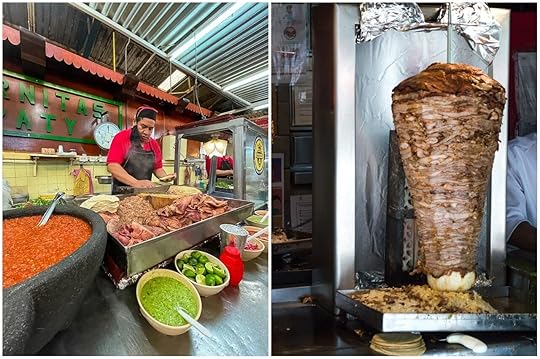
Photo: Airbnb
Experience the delicious street food of Mexico City with one of Mexico’s Airbnb Food Tours. This food tour will take you to one of the traditional markets in Mexico City, and there you will learn the importance of these types of places when it comes to traditional street food. You will also learn about the history of Mexican snacks and different street food stalls exploring places like the Zócalo.
Price: From $33 per person
Authentic Mexican Taco Food Tour – Cancún
Photo: Airbnb

Photo: Airbnb

Photo: Airbnb
In this tour, you will stop at five different stops and try different types of street-style tacos. Each visit will include choosing between 15 types of Mexican beers for a refreshing beverage. You’ll learn about the city’s history and the story behind each location you’re visiting while having the best tacos of your life. Here’s a preview to whet your taste buds: multiple styles of street tacos await, as does Yucatecan cuisine, Tacos al Pastor at a historic restaurant, and churros to cap the experience.
Price: From $65 per person
Vegan Mexican Food Walking Tour – Playa Del Carmen
Photo: Airbnb

Photo: Airbnb

Photo: Airbnb
Looking for vegan options when taking a food tour? Look no further and experience the best of Playa del Carmen’s bustling vegan scene. This vegan option food tour will take you on an adventure to discover the flavors of Mexican food in downtown PDC while enjoying the sunshine and stopping to check out hotspots (including beach views) along the way.
Price: From $59 per person
Food Tour with a local foodie — Puerto Vallarta
Photo: Airbnb

Photo: Airbnb

Photo: Airbnb
Enjoy this local foodie tour and learn about Puerto Vallarta’s food scene with a local expert. You will visit family-owned restaurants and meet artisans. You will also learn about taco culture — including how to choose taco stands — and fun cultural and historical facts.
Price: From $49 per person
Taking a trip to Mexico City? Check out Matador’s guides to the best places to stay across CDMX:The best Airbnbs in and around Mexico City’s historic center8 La Condesa Airbnbs to settle into Mexico City’s coolest neighborhood8 stunning Polanco Airbnbs in the city’s most international neighborhood8 gorgeous Roma Norte Airbnbs in Mexico City’s artsiest neighbhorhoodBikes and Munchies — Mexico City

Photo: Airbnb

Photo: Airbnb
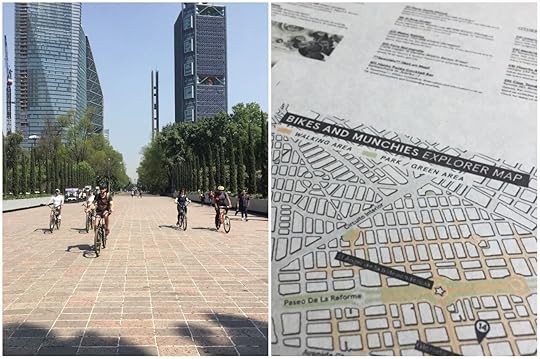
Photo: Airbnb
This unique Mexico Airbnb food tour guides you around the beautiful Mexico City to try delectable food on a bike. Explore Mexico City’s colorful markets, vibrant central-city neighborhoods, and get insight into Mexican food, culture, and history. With a minimum of two people, you’ll cruise about nine miles with numerous stops along the way including some of the city’s famous green spaces.
Price: From $57 per person
The Valle food & wine tour with People & Planet – Valle de Guadelupe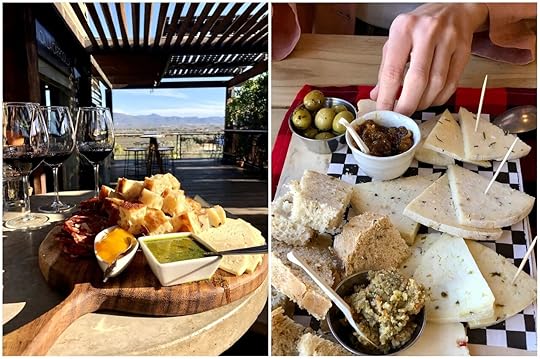
Photo: Airbnb

Photo: Airbnb

Photo: Airbnb
Experience classic Valle cuisine with great wine on this Mexican food tour. Baja-med, they call it, and what you’ll experience is food that is sustainable, locally sourced, and freshly prepared for your group. This one starts early with breakfast, do a bit of wine touring, enjoy a late lunch, and cap it off with a final toast. This tour is an immersive experience that will be the defining memory of your trip.
Price: From $326 per group
Original Downtown San Miguel Food Tour – San Miguel de Allende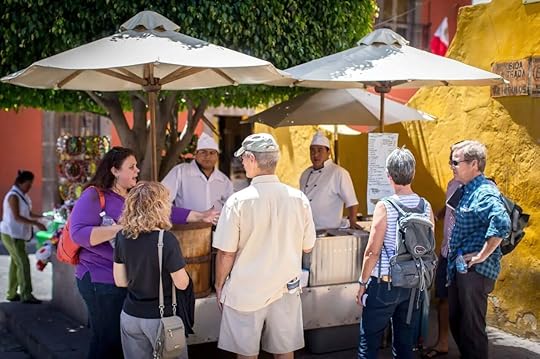
Photo: Airbnb

Photo: Airbnb

Photo: Airbnb

Photo: Airbnb
Delve into the city of San Miguel de Allende with this delicious food tour. Join Vail, a licensed federal tour guide, who will take you on tour to dine at local restaurants and visit multiple street food vendors. San Miguel is known for its buzzy cafe scene and lively street parties, and this tour puts you right in the middle of the action. 
Price: From $55 per person
More like thisVegetarianMexico City’s Most Mouth-Watering Vegan Street TacosThe 10 Best Miami Tourist Attractions That Are Actually Worth Visiting

Few cities in America combine the allure of a luxurious vacation with unapologetic tourist traps quite like Miami. For every postcard-perfect beach and provocative art installation, there’s a promoter hocking “VIP” club packages and a restaurant charging $50 for a bowl of spaghetti. So knowing which Miami tourist attraction is worth your time and money, and what’s a classic Miami scam, is crucial.
Around the city, some Miami tourist attractions are always worth a visit, and many are even free. You may have to deal with throngs of other visitors, but there are some Miami tourist spots that should always top your list.
1. Ocean Drive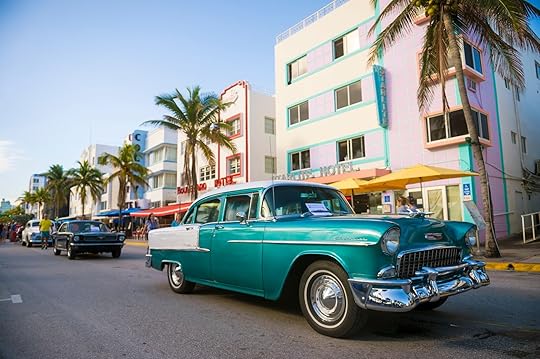
Photo: lazyllamaShutterstock
Miami locals tend to avoid Ocean Drive like they avoid ice scrapers and income taxes. In doing so, they’re taking the largest collection of art deco buildings in the world for granted. The stretch of pastel and neon hotels that runs along the beach from 5th Street to 14th Street is one of the most architecturally distinctive stretches of road in America, and it’s worth a stroll even if you aren’t trying to down three-for-one margaritas the size of your head.
While the street is certainly full of tourist trap restaurants, spots like Cafe Americano, A Fish Called Avalon, and LT Steak and Seafood are legitimate destination dining. You’d also be remiss to skip the venerable Clevelander, a staple party spot where you can sip on Miami Vices and watch the poolside mayhem unfold.
2. Frost Science Museum
Photo: Olga V KulakovaShutterstock
The Frost Science Museum is a combination aquarium and science museum that might be the best way to learn about Miami while still stoking your Insta feed. Start on the top floor, which has a panoramic view of the city skyline and port beyond, then stroll through a mocked up Everglades before staring down into the multi-story aquarium. The Royal Caribbean Vista also gives you a chance to pet stingrays and glimpse a rare Roseate Spoonbill.
Venturing downstairs is like walking through an air conditioned coral reef, finishing in front of the Oculus, a ground floor look-up into the aquarium where you can take a selfie with hammerhead sharks. The Frost also has a hall of rotating exhibits, and entire galleries devoted to mammoths and the history of flight.
3. Coral Castle
Photo: BorisVetshevShutterstock
Perhaps the most curious Miami tourist attraction is the Coral Castle. It’s not so much a castle as a fort and sculpture garden made entirely from coral and limestone. But what’s most impressive about this rock palace is that the entire thing was constructed by one man between 1923 and 1951: the superhuman Ed Leedskalnin. How he built it is still a Miami mystery, but the nine-ton gate, Polaris telescope, and working rocking chairs all help make this the greatest man-made wonder in South Florida.
4. Vizcaya Museum and Gardens
Photo: Songquan DengShutterstock
The former home of early 20th century industrialist John Deering is a marvel of architecture and engineering. Vizcaya Museum and Gardens is a 54-room, 45,000-square-foot bayfront mansion was modeled after the great castles of Europe, complete with three-foot walls and 180 acres of ornate gardens. It also has a small, sculpture-lined barge sitting just across the water from the main house, as well as countless artisan ceilings and tapestries from around the world. There’s also an orchid garden, an indoor-outdoor pool, and a kitchen that was far ahead of its time.
Do yourself a favor and spring for the guided tour to learn the backstory of the place, then take an hour or so and stroll around the gardens. Drink plenty of water, especially if you come during the summer. Bug spray and comfortable clothes are never a bad idea.
5. Wynwood Walls
Photo: Julian Prizont-CadoShutterstock
Miami’s Wynwood neighborhood was once a funky artists’ enclave filled with colorful murals plastered on forgotten industrial buildings. And though it’s gotten aggressively gentrified and turned into a full-blown Miami tourist attraction over the past decade, the outdoor museum is no less impressive. The main Wynwood Walls park has the biggest collection of permanent murals, but also has a small entrance fee. If you’re opposed to paying it, you can also stroll the streets and find murals ranging from political statements to local sports team tributes.
Wynwood is also home to some of the best breweries in Miami, like the Star Wars-themed J. Wakefield and Dogfish Head’s Miami outpost. You can also stop into the Museum of Graffiti to learn all about the history of this urban art form. Or hit the rooftop at Astra for a birds-eye view of murals that stretch for blocks in every direction.
6. Monastery of St. Bernard de Clairvaux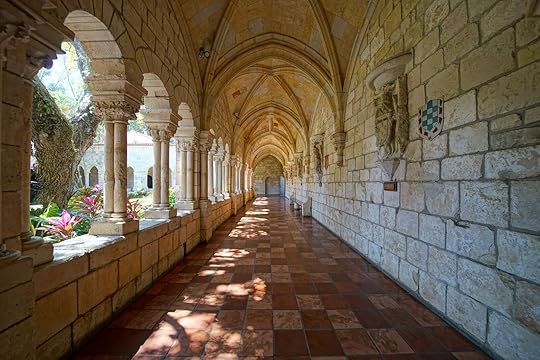
Photo: Mariusz LopusiewiczShutterstock
It can be hard to believe there’s a building in Miami that dates back to 1141, especially since the city wasn’t even founded until 1896. But venture up to North Miami Beach and you’ll find the Monastery of St. Bernard de Clairvaux, which sat in Segovia, Spain for nearly 800 years. In 1925, William Randolph Hearts bought the cloisters and outbuildings, and then had them dismantled and shipped to America. He ultimately was forced to sell them, and the 11,000-or-so crates that contained it sat in a warehouse until the 1950s.
Two businessmen bought the monastery with the intent of turning it into a tourist attraction, though it ultimately ended up being donated to the Bishop of Florida. Today, it’s an active congregation but no less fascinating to visit, an odd piece of medieval history set in the middle of South Florida.
7. Calle Ocho
Photo: Fotoluminate LLCShutterstock
Once a rough-and-tumble enclave of Cuban immigrants, Calle Ocho – the main drag through Little Havana – is now filled with tour buses and visitors sipping mojitos. But it’s managed to avoid turning into Ocean Drive West, and the collection of Cuban cafeterias, cigar shops, and hole-in-the-wall restaurants has helped the place retain its character.
A trip down Calle Ocho isn’t complete without a drink at Ball and Chain, an historic jazz club that was restored to look like it did during its 1930s heyday. There’s live music almost daily, performed under a bandshell shaped like a pineapple. You’ll find some of the best cocktails in the city at Café La Trova, where a live Cuban band and 80s-themed back bar complete the motif. Also make a point to wander the Cubaocho Museum and Performing Arts Center, home to the world’s largest collection of pre-revolutionary Cuban art.
8. Monkey Jungle
Photo: Oliver SvedaShutterstock
Monkey Jungle takes the zoo concept and almost literally turns it on its head. Here, humans stroll through cages while monkeys roam free. The 30-acre park emulates natural primate habitats, where java monkeys, gorillas, orangutans, howlers, and other animals bound by strolling visitors. The park also hosts frequent educational shows with the park naturalists (be sure to check with Monkey Jungle for which ones are running before going). A tour here is one of the most immersive primate experiences you can have without crossing an ocean.
9. Venetian Pool
Photo: MeunierdShutterstock
Once a rock quarry used to build the surrounding suburb of Coral Gables, these spring-fed pools are like a natural swimming club surrounded by historic Mediterranean architecture. Though it can get packed with families on the weekend, stopping in during the week feels like finding a truly hidden gem, where you can cool off and enjoy the balmy weather in a shady jungle setting. It’s the only swimming pool on the National Register of Historic Places, and was a celebrity hotspot during the 1930s when stars like Esther Williams and Johnny “Tarzan” Weismuller were often spotted.
10. Everglades National Park
Photo: Francisco BlancoShutterstock
It’s hard to call a national park a “tourist attraction,” but the unusual ecosystem of South Florida’s signature swamp still draws visitors by the thousands. Even if you’re just taking bikes through Shark Valley or strolling the short Anhinga and Gumbo Limbo tails, you’ll still walk straight into landscapes of flora and fauna you’ll never see elsewhere. Alligators are, of course, common, though attacks are infrequent. And if you want to see what Florida was like before it was all condos and strip malls, nowhere showcases it quite like the majestic River of Grass.
The 6 Most Underrated Caribbean Beach Towns You Need To Visit

The Caribbean refers to a chain of over seven hundred island nations, islets, reefs, and cays washed by the Caribbean Sea. These islands and cays are located close to the Equator in the northwestern hemisphere, allowing them to share a delightful 80° climate or hotter on most days of the year. Each year, droves of tourists flock to the Caribbean to experience the delightful melting pot of food, sights, and sounds that are uniquely Caribbean, as well as to enjoy the tropical maritime climate–especially during cold snowy winters up north.
Many Caribbean nations utilize the year-round sun, sand, and sea as a major marketing tool for potential and returning tourists, but the beaches advertised in the travel brochures are often crowded and over-commercialized.
Check out these underrated Caribbean beach towns for an authentic island experience and a richer connection to the culture.
Port Antonio, JamaicaPort Antonio is a small coastal town on Jamaica’s northeastern coast that is home to a little over 12,000 residents. The town is bordered by the Caribbean Sea to the north and the Blue Mountains on its southern end, which produces the world-renowned Jamaican Blue Mountain coffee on its steep hillsides. Port Antonio is home to some of the Caribbean’s best white-sand beaches, such as Winnifred Beach, San San Beach, and Frenchman’s Cove.

Photo: ajlatan/Shutterstock
The Boston Jerk Center lies on Boston Beach in Port Antonio and is said to serve the island’s best jerk, as the style of jerking meat originated in the nearby hills. Boston Beach is an excellent spot for surfing, and the charming markets and tropical fruit stalls are sure to keep one busy. Port Antonio is a stomping ground for the world’s wealthiest vacationers but remains affordable and practical for budget travelers with numerous hostels, small guesthouses, and boutique hotels. If one ever tires of the beach in this coastal town, the dreamy rainforests, rivers, and lagoons beckon. Bamboo raft on the Rio Grande and explore remote waterfalls in the Upper Rio Grande Valley, less than thirty minutes drive from the town center.
Willemstad, CuraçaoThis endearing colonial beach town is located on the Dutch-speaking island of Curaçao. Unlike the expansive white-sand beaches which typically land on Caribbean postcards, Willemstad’s beaches are located in intimate, secluded coves and inlets. Some have facilities that attract a small user fee, such as at Mambo Beach, while others remain wild and free with lots of personality.

Photo: Oliver Hoffmann/Shutterstock
Blue Bay Beach offers water sports and activities such as snorkeling, fishing, catamaran sailing, and kayaking that can be arranged at dive shops on the beach. You need not have your own equipment. You may spot sea turtles, squid, octopus, and scores of fish as you snorkel in Curaçao’s azure waters. Purchase delicious seafood on the beach, which is prepared from the day’s catch, or take a day trip into town to explore the restaurants, markets, and Ostrich Farm.
Also, be sure to check out the Queen Emma Swinging Bridge and take a photograph with the town’s iconic cotton candy-colored buildings as your backdrop.
Northern TrinidadTrinidad is the larger of the two islands that comprise the twin-island republic of Trinidad and Tobago. Instead of merely transiting through Trinidad to get to Tobago, leave the Piarco International Airport and spend a few days in the Trinidad north coast beach towns of Maracas Bay and Las Cuevas. These beaches are mainly popular with the local crowd but are home to the country’s best bake and shark–a popular Trinidadian street food that consists of deep-fried shark meat sandwiched by a fluffy flatbread and condiments of your choice.

Photo: KBYC photography/Shutterstock
The waves are rough compared to other beaches on this list but offer excellent surfing and bodyboarding opportunities. Venture a bit further along the North Coast Road to the sleepy beach town of Blanchisseuse. Blanchisseuse bears testimony of a time when northern Trinidad was occupied by the French. The beach is located on an expansive stretch of white sand dotted with attractive coconut trees. Outside of Carnival season, Trinidad is not as heavily visited as other islands on this list, which means that you can explore without beach peddlers trying to sell you souvenirs. Also, all beaches in Trinidad are free for locals and foreigners alike. Feeling adventurous? Explore the nearby Paria and Avocat Waterfalls.
True Blue, GrenadaTrue Blue is a tiny beach town located on Grenada’s south coast where the Caribbean Sea meets the Atlantic Ocean. This secluded town features a popular marina and dive shop. Fine restaurants, shops, commercial centers, and the best Grenadian south coast beaches, such as Grand Anse Beach, are all within a one-mile radius.

Photo: Pawel Kazmierczak/Shutterstock
The island’s only international airport is located less than a mile and a half away from True Blue, which makes getting around a breeze. If you’re feeling adventurous, take a 30-minute cab ride from True Blue to catch Osprey Lines Ltd. ferry to the other two islands that make up the Grenadian tri-island state, namely Carriacou and Petite Martinique. Time your visit well and check out the annual 6-day Grenada Chocolate Festival in May. Shuttles to the festival depart from True Blue. Also, have you ever thought about studying in paradise? St. George’s University, a private medical school, and international university situated on the True Blue Peninsula, could turn that dream into reality.
Freetown, Antigua
Photo: BlueOrange Studio/Shutterstock
Freetown is a sleepy town on Antigua’s southeastern coast, which is home to the beautiful pink sands of Half Moon Bay Beach. The sand at this beach gets its pink hue from crushed coral. This charming beach lacks standard beach infrastructure, so carry everything with you when visiting, such as food and drink. From Half Moon, you can walk to other popular beaches, like Exchange Bay Beach. If you feel up to it, rent a car or take a taxi from Freetown to check out other attractions within a 10-mile radius, such as Antigua’s Donkey Sanctuary, Stingray City, and the Devil’s Bridge National Park in Willikies. One can never grow tired of the beach in Antigua. Antiguans quip that the island has 365 beaches, one for every day of the year.
Rodney Bay, St. LuciaRodney Bay is a beach town located on St. Lucia’s northwestern coast in the Gros Islet District. The town has a busy marina, an active nightlife scene, and popular white-sand beaches such as the Reduit and Pigeon Island Beaches. Check out the street party, which happens every Friday night in Rodney Town and features live deejays playing zouk, reggae, rhythm and blues, and calypso. A 2-mile drive takes you to Donkey Beach for a more secluded beach vacation. You can even continue further south to the remote Grand Anse Beach to hopefully spot St. Lucia’s sea turtles. Also, the dramatic Gros and Petit Piton volcanic peaks on St. Lucia’s southern coast make for another delightful day trip from Rodney Town. 
The 9 Best Great Smoky Mountains National Park Hotels

Great Smoky Mountains National Park is America’s most visited, and for good reason. Its trails, views, and history make it one of the most important (and beautiful) parks in the National Parks Service.
As far as parks (well, at least parks outside of Alaska go), it’s big. It’s the 11th largest in the lower 48 and well over 500,000 acres. So to properly experience it, you need to spend at least two days exploring. Most visitors to Great Smoky Mountains National Park enter through the Sugarlands entrance in Tennessee, just outside the towns of Gatlinburg and Pigeon Forge. Others come in through the main southern entrance near Cherokee, North Carolina.
In terms of pricing, the average nightly rate varies more by season than by town. Hotels will be the most expensive between May and September (peak hiking season) and drop to their lowest between December and January. Winter rates can be a fraction of the peak summer rates, so keep that in mind if you’re trying to plan a budget trip.
Whichever you choose, these are the best Great Smoky Mountains National Park hotels, lodges and places to stay.
Looking to stay in a cabin? Check out Matador’s guide to all the best cabins near Great Smoky Mountains National Park
We hope you love the lodges and hotels near Great Smoky Mountains National Park we recommend! Just so you know, Matador may collect a small commission from the links on this page if you decide to book a stay. Listed prices are accurate as of the time of publication.
Lodging inside Great Smoky Mountains National ParkWhere to stay in Pigeon ForgeWhere to stay in GatlinburgWhere to stay near the southern entrance to Great Smoky Mountains National ParkThe only Great Smoky National Park hotel in the parkLeConte Lodge
Photo: Martina Sliger/Shutterstock
LeConte Lodge is the only lodging inside Great Smoky Mountains National Park boundaries. Only accessible via a minimum five-mile hike, accommodations are rustic but classic – you’re rewarded with fresh-cooked meals and a cozy place to sleep inside a simple but comfortable cabin. There’s no more authentic way to experience the park than to spend a night here swapping adventure stories with fellow guests over a beer while taking in the striking quiet and peacefulness of the park at night. Sack lunches are available for purchase from the gift shop in the morning. Be advised that weather on Mt. LeConte varies, and there are no roads or cars – pack it in, pack it out.
To book, call 865-429-5704. Reservations are first-come, first-served, and the waitlist is closed for the 2022 season – though cancellations do occasionally occur.
Price: $162 per person (includes meals)
Where to stay in Pigeon ForgeCountry Cascades Waterpark Resort
Photo: Booking.com
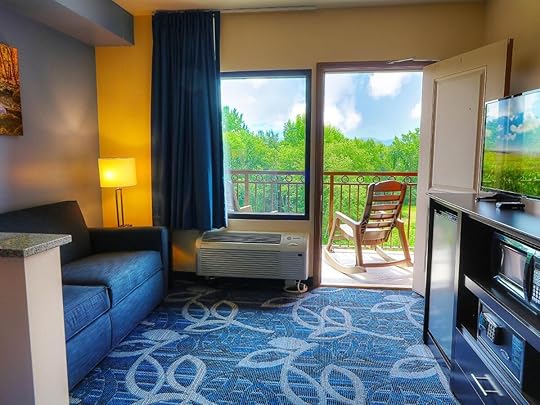
Photo: Booking.com

Photo: Booking.com

Photo: Booking.com
No Great Smoky Mountain National Park hotels are better suited to families than the Country Cascades Waterpark Resort. With multiple slides, a large pool, a kiddie pool, and a hot tub, this is the spot to let the kiddos – and the adults – unwind. Rooms are spacious and cozy, with space to lounge and views of the green mountains over yonder. It’s definitely the best of the Pigeon Forge Great Smoky Mountains National Park hotels if you plan to hit Dollywood since it’s equidistant between the theme park and national park. There’s no better place to feel like you’re at a beach resort in the heart of Appalachia.
Price: From $90 per night
Twin Mountain Inn and Suites
Photo: Booking.com

Photo: Booking.com

Photo: Booking.com

Photo: Booking.com
Overlooking the river and with mountain views on three sides, Twin Mountain Inn and Suites is the best of hotels near Great Smoky Mountains National Park for watching the sunrise (or sunset). There’s usually morning mist hovering over the hills as you enjoy the breakfast buffet, setting the mood for an unforgettable day in the park. If you spend a day outside the park, you can walk to Dolly Parton’s Stampede or the Old Mill shopping area, or hop a short ride over to the Dollywood theme park and The Grand Majestic Theatre. This is Pigeon Ford’s best hotel for couples, not only because of the views, but because it has a higher-end pool and lounge area and is very close to restaurants and nightlife in Pigeon Forge. Oh, and because many rooms include large hot tubs.
Price: From $71 per night
Margaritavilla Island Inn
Photo: Booking.com

Photo: Booking.com

Photo: Booking.com

Photo: Booking.com
Who doesn’t love a taste of Key West in Tennessee? The Margaritaville Island Inn is the bustling, fun, and perfectly convenient option for your trip to Great Smoky Mountains National Park. The amenities and attractions of Pigeon Forge are within walking distance, and the park itself is a mere 20 minutes away on Highway 321. The hotel features both an indoor and outdoor pool, a superb continental breakfast, and views that make you feel as though you’re in a high-rise penthouse in . . . well, Pigeon Forge. But given the nearby theme parks, that’ll do just fine.
Price: From $89 per night
Where to stay in GatlinburgOld Creek Lodge
Photo: Booking.com

Photo: Booking.com
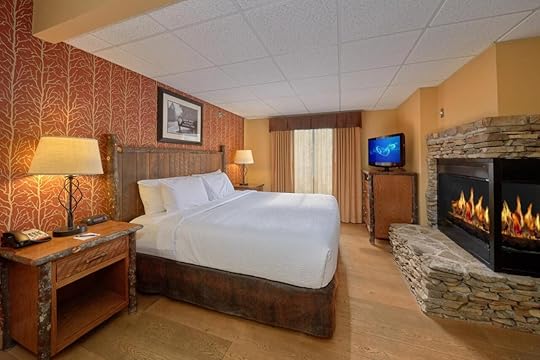
Photo: Booking.com

Photo: Booking.com
In downtown Gatlinburg, the Old Creek Lodge offers the best of both worlds. It has quick and easy access to Great Smoky Mountains National Park and walkability to dining, shopping, and other amenities in the town center. Cozy up next to the fireplace in your room after adventuring, have a dip in the outdoor pool, and then wake up refreshed and hit the breakfast bar on your way back out for another day of playing in the park. This is a great pick among great Smoky Mountains National Park hotels for couples looking to experience both nature and a date night afterward.
Bonus: this property is available for a Booking.com Genius discount, so you’ll get points you can spend on future hotel stays when you book.
Price: From $114 per night
Edgewater Hotel and Conference Center
edgewater hotel great smoky mountains national park hotels
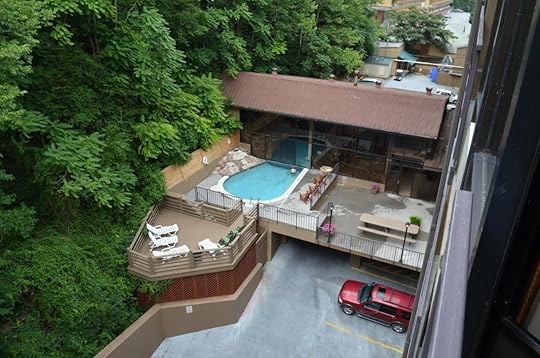
Photo: Booking.com

Photo: Booking.com
Edgewater Hotel and Conference Center is among the nicest hotels near Great Smoky National Park. Rooms have balconies overlooking the hills and the pool is an indoor-outdoor hybrid. The property is accustomed to large groups and business travel (so you know the WiFi is on point) and the downtown location means you can grab a nice meal before crashing for the night without venturing too far if your legs are sore from a day hiking in the park.
If you do want to do some exploration in town, the Mountain Mall, Space Needle, and the dining scene in downtown Gatlinburg are within walking distance. If you’re a remote worker or freelancer who usually needs to work a bit while traveling, but still want to get in full days in the park, Edgewater is a great option.
Price: From $129 per night
Bearskin Lodge on the River
Photo: Booking.com

Photo: Booking.com
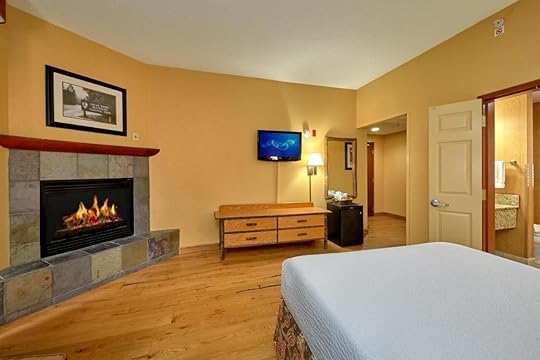
Photo: Booking.com
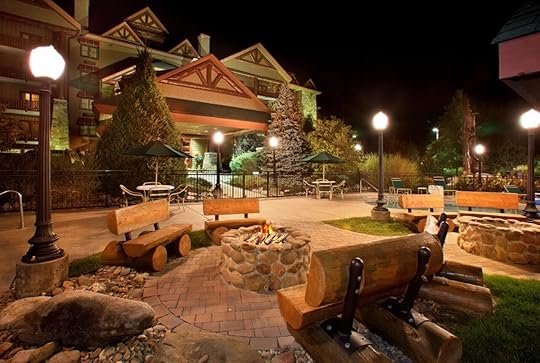
Photo: Booking.com
Who doesn’t love a lazy river after a day of hiking, biking, or sightseeing? Bearskin Lodge is home to Gatlinburg’s quaintest outdoor lazy river and pool, making this the best of the Great Smoky Mountains National Park hotels for families. The resort is between downtown and the park – which, of course, means more playtime for the kiddos and for adults and more time to relax and recover for another day of exploring. Rooms are cozy and clean, maintaining the rustic mountain aesthetic without sacrificing comfort. This is a great lodge for small groups and families.
Price: From $144 per night
Bonus: this property is also available for a Booking.com Genius discount when you book a stay.
Check out Matador’s guide to Gatlinburg Airbnbs for your trip to Great Smoky Mountains National Park.
Great Smoky Mountains National Park hotels near the southern entrancePanther Creek Cabins – Cherokee, North Carolina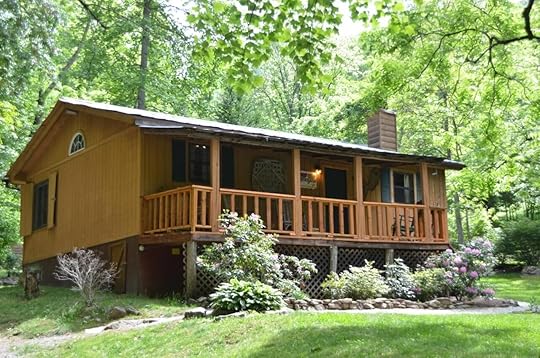
Photo: Booking.com
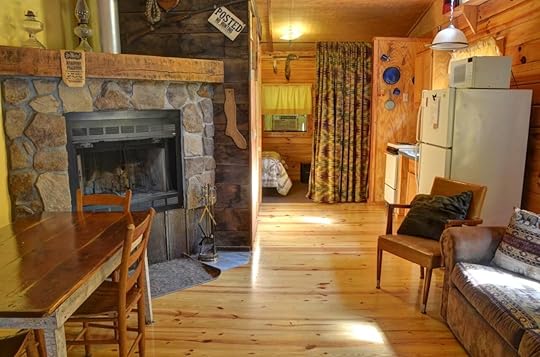
Photo: Booking.com

Photo: Booking.com
Cherokee, North Carolina, is full of cozy mountain cabins to serve as basecamps for a trip to Great Smoky Mountains National Park. But reviewers especially love the Panther Creek Cabins, which gives you both easy park access and an incredible lodging experience that embodies the true spirit of Appalachia. Hike the surrounding property, head into Cherokee for dinner, soak in the hot tub, or even do a bit of gambling up the street at Harrah’s Casino, if that’s your thing. You sacrifice by leaving WiFi and civilization behind, but you gain a truly immersive experience in the Smokies – something we could all use right about now.
Price: From $109 per night
Historic Tapoco Lodge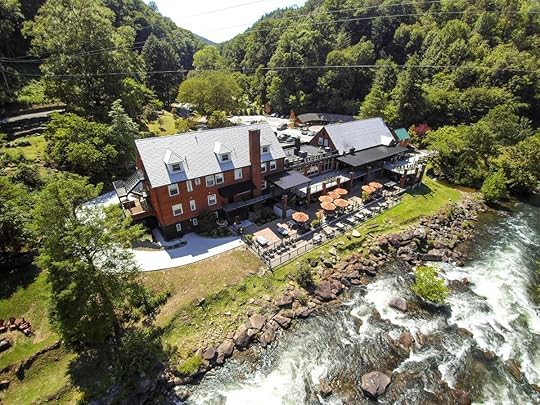
Photo: Booking.com
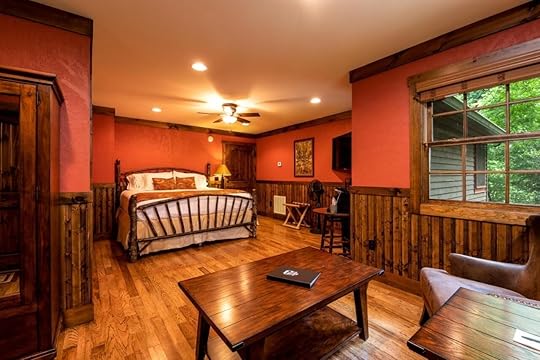
Photo: Booking.com
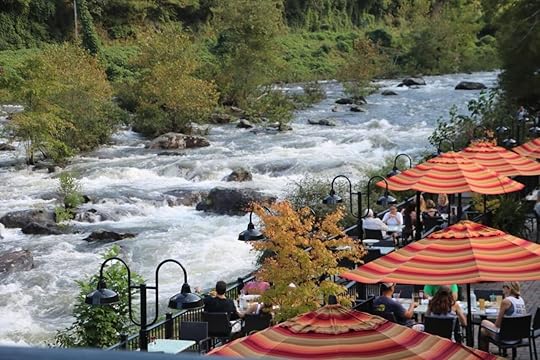
Photo: Booking.com

Photo: Booking.com
Far from the hustle and bustle of the Sugarlands entrance is the Historic Tapoco Lodge. It’s an ode to the good ole’ days of early tourism in the Smokies, back when it was all about getting out into nature and leaving the city behind. From the lodge, you can kayak Chilhowee Lake (actually more like a river), raft the Cheoah River, or see the lesser-traveled side of Great Smoky Mountains National Park. Be sure to grab a pizza and a beer from Tapoco Tavern one night, perhaps to celebrate being one of the few who actually hike their way into the park (you’ll be proud of yourself for skipping the line of traffic up north).
Price: From $159 per night
Staying in (or traveling through) Asheville? Check out Matador’s guide to the best Asheville Airbnbs. 
I’ll Say It: New Hampshire Hiking Is Just as Good as Hiking in the Colorado Rockies
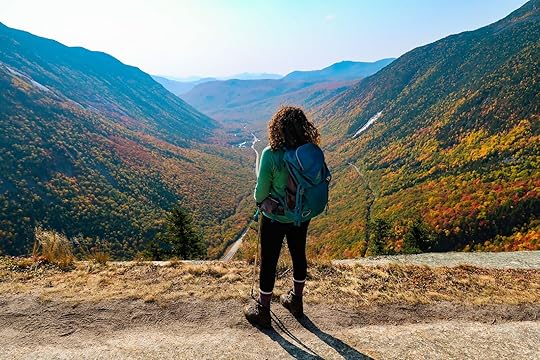
While New Hampshire might not be on anybody’s list of “states for epic adventure,” they might think differently once they experience the White Mountains.
Imagine a place with craggy peaks, alpine lakes, impressive ridgelines, and jaw-dropping cliff faces. For most people, that may bring to mind visions of the Rocky Mountains, North Cascades, or Utah’s Uintas Mountains. I lived in Colorado for almost a decade, and there’s no debating that the Rockies are an incredible place to adventure. But as someone who now lives in New England, I’m confident enough to say that New Hampshire hiking is just as good – if not better – than hiking in the Rockies.
Before any Coloradans get too upset, I’m not saying that the Rocky Mountains aren’t great, or that they don’t deserve the many hiking superlatives tossed their way. But hiking in New Hampshire’s White Mountains is shockingly amazing and, as far as I’m concerned, comparable in terms of scenery and adventure. Here’s why.
It’s easier to find personal space
Photo: Joseph Jacobs/Shutterstock
I lived in Colorado for many years, and despite how difficult some of the trails are, the most challenging part of every hike was finding a parking spot at the trailhead for my tiny sedan. Almost every trailhead within a two-hour drive of Denver was jam-packed before 8 AM every day. And when I happened to find a spot, the conga line up the trail was no reprieve from the crowds.
The White Mountains, on the other hand, are surprisingly empty. Of course, certain New Hampshire hikes like Mount Willard and the Flume Gorge get crowded, especially in the fall – also known as leaf-peeping season. Overall, though, the hikes are so spread out in the Whites Mountains that solitude is the norm, not an oddity.
Fall color is better here
Photo: Jon Bilous/Shutterstock
Nothing can compare to New England in the fall, especially in the White Mountains. Fall in Colorado might be striking, but it’s usually two colors: yellow and green. But New Hampshire hiking trails show the entire spectrum of fall colors. A single tree can create a full rainbow of colors: maples vary from yellow to orange to deep burgundy, depending on the species. Add to that yellow birches, orange beeches, reddish-brown oaks, and greens from spruces and pine trees, and you’ve got a full-fledged symphony of color.
Trails are more accessible
Photo: ladyphoto89/Shutterstock
Some of the best trails I’ve hiked in Colorado started at trailheads accessible only by high-clearance or four-wheel drive vehicles. That meant many people didn’t get to see those parts of the Rocky Mountains simply because they didn’t have the right car. Many of the best trailheads are a long drive down mountain roads at least an hour away from any development, and you couldn’t even think about reaching those trailheads when the roads were covered in snow or ice.
New Hampshire hiking, however, is very accessible, and it’s easy to reach the White Mountains, even in winter. Most roads stay open year-round in the White Mountains, though it’s still important to check the status on the NH Department of Transportation before heading out. Hardly any trailheads require a high-clearance vehicle, and I never have to drive hours to reach a trailhead. In fact, in four hours, I can be in Burlington, VT; Boston, MA; Portland, ME; or even cross the border into Montreal.
The Whites also have a cog railway
Photo: Jon Bilous/Shutterstock
One of my favorite things to do with visiting friends in Colorado was to take them to the top of Pikes Peak on the cog railway. It offered friends a chance to sit at the summit of a 14er without doing much work. But Pike’s Peak isn’t the only one: there’s a cog railway on Mount Washington.
It was the world’s first cog railway to summit a mountain and welcomed its first paying customers in 1868. And I think the views from the top are better. On a clear day, it’s possible to see north to Canada, east to the Atlantic Ocean, and across five different states (New Hampshire, Vermont, Maine, Massachusetts, and New York). And every once in a while, it’s even possible to view the northern lights.
No elk, but plenty of moose
Photo: Doug Vinez/Shutterstock
A huge draw of Rocky Mountain National Park is the high likelihood of witnessing elk rutting in the fall. The hauntingly beautiful bugle from the males as they try to call a mate is a song I love to hear. However, the White Mountains are home to a thriving moose population, and they’re just as incredible as elk. It’s possible to see them on many of the best New Hampshire hikes; experts think there are about 3,500 throughout the state.
The hikers are kinder
Photo: Blazej Lyjak/Shutterstock
New England may have a reputation for being a place where people are always in a rush and never have time to spare. That’s truer than it is in, say, the midwest, but it’s really only around Boston that you’ll notice it on a daily basis.
I’ve found that most of the time, hikers in the White Mountains are inherently kind. They know trail etiquette (perhaps because fewer are tourists?) and are more than willing to wave hello or strike up a conversation.
I’m not sure why hikers on trails in the Rockies seem more standoffish. It might be because they’re jaded from overtourism and annoyed at the many visitors taking over their beloved trails. Or it could be that many Colorado locals think their state has the hardest hiking in the country, and therefore think it’s their job to offer unsolicited advice. It’s hard to forget the time a man I didn’t know cautioned me that it’d be hard to hike with my 25-pound toddler in a backpack.
Walking on granite is more of a challenge
Photo: Dan Hanscom/Shutterstock
The White Mountains are named for the color of the rock that forms most of its mountain summits. It’s granite, which is also why New Hampshire is called the Granite State. Many of the state’s mountain summits are relatively short jaunts (less than four miles), but the elevation gain is astronomical; many gain upward of 1,500 feet of elevation in a mile of distance. Unless you regularly use a Stairmaster, you can expect to feel the effort in your butt muscles after a mile or two.
I’ve hiked on sand dunes, gravelly mountain summits, and grassy alpine ecosystems in Colorado. But New Hampshire hiking is generally more challenging thanks to the solid granite slabs in the White Mountains. Even with the grippiest of boots, uphill and downhill travel is a struggle. At just over five feet tall, it’s a struggle sometimes to step up steep sections. But I like that extra challenge.
You’ll earn legit bragging rights
Photo: Jerry Gantar/Shutterstock
In the heart of the White Mountains is Mount Washington, notorious for wild weather. There are three major wind patterns in North America and they collide in one spot: the White Mountains. Mount Washington is also the most topographically prominent mountain east of the Mississippi River, so those wind patterns can travel unobstructed before smashing into Mount Wash. The weather can change at the drop of a hat – and, by the way, you’ll need a snug hat to hike above the treeline there.
In Colorado, it’s easy to see approaching weather patterns, making it easy to gauge when it’s time to turn around. Not so in the Whites. Many hikers have died of exposure on Mount Washington, making it the deadliest mountain in the US. Daily wind speeds often clock in at more than 30 miles per hour, with tropical-storm-level gusts registering several times per week. It’s no walk in the park (despite the fact that it is, actually, in Mount Washington State Park).
Preparing for a New Hampshire hiking tripLower elevation doesn’t mean easier hiking, and you shouldn’t under-pack or discount the challenge of hiking in New Hampshire. There’s much to prepare to ensure a safe (and fun) hiking trip in the White Mountains.
Packing
Photo: Maridav/Shutterstock
Hikers will want to buy the $25 New Hampshire Hike Safe Card. It’s similar to the Colorado Outdoor Recreation Search and Rescue Card and reimburses your rescue costs should you need it. It’s cheap and one of the best things you can do for your safety (and wallet) when hiking in New Hampshire.
Pack for all weather conditions, even in the summer, as temperatures and weather change rapidly. I’ve experienced hikes that were 87 degrees F at the trailhead, raining and hailing on the way up, and 42 degrees and windy at the summit. Wear wicking base layers and pack enough outer layers to stay warm and dry, including a wind- and waterproof layer. Consider packing the “10 essentials,” which many hikers consider must-have items for any day hike.
Getting to New HampshireReaching the White Mountains is easy from most New England cities. Most people will want to fly to Boston’s Logan International Airport and rent a car to make the approximately 90-minute drive to towns in the mountains. There’s also a bus that leaves from Logan and stops in North Conway, Franconia, Gorham, Lincoln, and Plymouth, among other towns.
When to go
Photo: Ed Dods/Shutterstock
You can’t really go wrong no matter what time of year you visit the White Mountains. Summer and fall are the most crowded but also the most beautiful, and offer (theoretically) the best hiking conditions. Spring can be a bit miserable thanks to rainy weather and muddy trails, but it’s also when wildflowers and blooms put on their best show. Winter is popular if you like to snowshoe or cross-country ski, and the trails are much less crowded as most people head to the slopes.
Where to stayWhite Mountain National Forest covers almost 800,000 acres across dozens of towns. Most people stay around North Conway, Plymouth, Gorham, or Lincoln. The state has hundreds of cute cabins and Airbnb rentals tucked between various mountain towns.
For unobstructed views of Mount Washington and elegant rooms, stay at the Omni Mount Washington Resort. For a more family-friendly experience, Loon Mountain Resort should fit the bill, and if you want to hike the Presidential Traverse (a very challenging hike), stay at the nearby Appalachian Mountain Club’s Highland Center. And North Conway’s Cranmore Inn is a charming B&B. 
LGBTQ guide to London

London tops the charts as not only one of the most multicultural cities in Europe but also one of the best LGBTQ+ destinations. Gay London is the heartbeat of queer life in the UK. Take a stroll through Soho, just one of the city’s many gay districts, and it’ll be quite clear that this city has much to offer LGBTQ+ travelers. From riotous drag shows at upscale cocktail bars to gay history collections at some of its premier museums, LGBTQ+ culture is never more than a tube ride away.
LGBTQ+ language in LondonThe best gay bars in SohoThe best gay bars in VauxhallThe best gay bars in the East EndLGBTQ+ events and festivalsLGBTQ+ museums and cultureWhere to stay in LondonLGBTQ+ day tripsLGBTQ+ language in LondonYou’ve probably heard of slang words like butch, camp, and queen. But, little known to most, these terms come from the queer underground world of pre-1970s London.
Back when the UK was a far less tolerant place, LGBTQ+ people used a secret language called Polari to communicate with one another. The language was a mixture of words from London cockney rhyming slang, Romani, and Italian.
Since homosexual acts were illegal, Polari enabled folx to talk safely in mixed company and identify as queer. The language was campy and playful: Bona to vada your dolly old eek, a common Polari greeting, meant “Nice to see your pretty face.” Dish meant “ass,” and bona dish meant “nice ass.”
Polari was widely spoken in the LGTBQ+ community until 1967 when homosexuality was decriminalized in the UK. Today elements of the language are common in drag culture and have even trickled into the mainstream. Tune into Ru Paul’s Drag Race UK or visit one of the city’s gay cabarets, and you’ll hear remnants of old London’s underground LGBTQ+ legacy.
LGBTQ+ neighborhoods and nightlifeSoho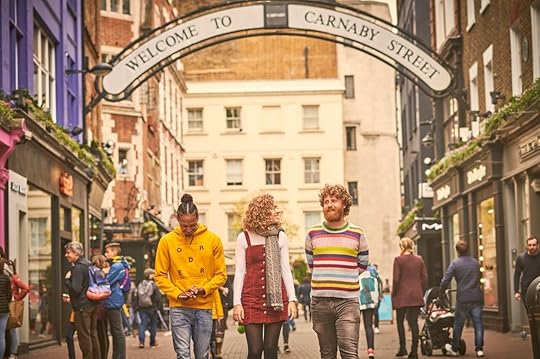
Photo: VisitBritain/Sam Barker
Soho is the front-and-center premier neighborhood of gay London. It’s centrally located and surrounded by many of the city’s major tourist sites, including the West End theater district. Soho is the spot for fancy cocktail bars, drag shows, “after works” and more. With so much nightlife concentrated in one small area, it can often feel overwhelming.
Freedom
Photo: Freedom Bar Soho/Facebook
There’s no grunge at Freedom. This upscale gay bar looks like a Restoration Hardware showroom. Plush couches, modern light fixtures, and real floral arrangements dot the ground level. A signature cocktail menu compliments the lavish ambiance.
If high society is not your thing, Freedom’s lower-level cabaret hosts a drag competition show on Monday nights. Similar to Ru Paul’s Drag Race, judges critique the queens after they finish performing. The show is rip-roaring hilarious and showcases some of the best drag talent in gay London.
Address: 60 – 66 Wardour Street
Comptons of SohoLike your tacky great aunt’s living room, Comptons is decked out with antiquated chandeliers and rickety furniture. Its creaky wood floors and random slot machines also contribute to that aesthetic. Outdated it may be, but Comptons is a neighborhood staple with a convivial atmosphere. It’s also the perfect starting point for those wanting to make the rounds, as it’s conveniently on the same block as three other bars.
Address: 51 – 53 Old Compton Street
VillageVillage is a modern gay club with a mix of chill and party vibes. They split the ground level into two lounge-style rooms, each with their own bar. The cellar is a foggy, neon-lit dance club where electronic music thumps all night. Also on Compton Street and within steps of several other bars, Village is a solid spot to add to a Soho bar crawl.
Address: 81 Wardour Street
Friendly SocietyFriendly Society is like taking an acid trip to a bizarrely magical place with garden gnomes and naked Barbie dolls at every turn. Come for the weird ambiance, but stay for the cocktails. Friendly Society has one of the best-rated drink menus in Soho, and its lounge setup is conducive for group conversation.
Address: 79 Wardour Street
She Soho
Photo: She Soho/Facebook
She is a bar for women. And being London’s only dedicated lesbian venue, it’s pretty militant about that (though it is trans-inclusive). Once inside, however, the bar has chill vibes and good music. DJs spin every weekend, and during the week there are kitschy-themed event nights. The bar’s swanky, futuristic interior gives the feeling that you’re on a lesbian spaceship. But remember, men, are not welcome aboard.
Address: 23a Old Compton Street
G-A-YJust like the name, what you see is what you get: a classic, no-frills gay bar. Everyone goes to G-A-Y, so if you only had one hour to spend in Soho, you should go here. The bar trends younger and is typically a 50/50 split between tourists and locals. There’s a terrace on the second level that opens when tank top weather rolls around. And it helps that the drinks are cheap, even after happy hour ends.
Address: 30 Old Compton Street
Vauxhall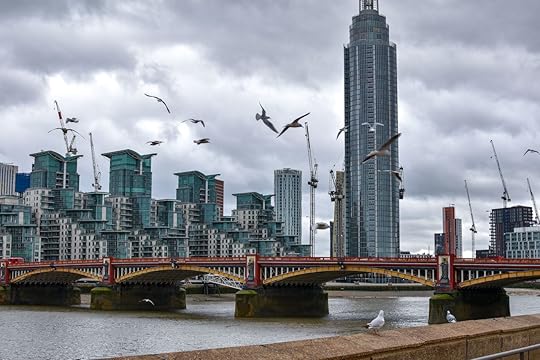
Photo: Dani Berszt/Shutterstock
Vauxhall is Soho’s badass punk rocker twin that lives on the south side of the Thames. It’s London’s original queer neighborhood, going back to when homosexuality was illegal in the UK. LGBTQ+ people pejoratively referred to as “mollies” defied the law by congregating in secret “molly houses” in this hood. That illicit spirit of defiance lives on in Vauxhall’s institutions today, and it’s where you go for LGBTQ+ history and/or wild nights at unorthodox bars.
Royal Vauxhall Tavern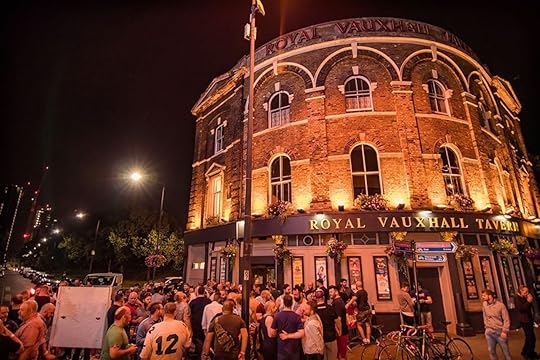
Photo: The Royal Vauxhall Tavern/Facebook
This iconic cabaret hall is nothing short of legendary. Among its many famous visitors was Freddie Mercury, who allegedly snuck Princess Diana inside disguised as a man. That was in the ‘80s, which is like last week as far as this institution is concerned. Dating back to 1860, Royal Vauxhall Tavern is London’s oldest standing LGBTQ+ venue, and it’s still showcasing some of the most entertaining cabarets in the city.
Address: 372 Kennington Lane
Eagle LondonLike its NYC and San Fran counterparts, Eagle London is a fetish bar for guys who like leather. Infamous for being a very cruisey spot, Eagle’s attempted to clean up its image in recent years. The newly renovated bar has a beer garden and hosts weekly parties with cult followings, like Horse Meat Disco every Sunday. Despite this, Eagle will always be synonymous with cruising, so be aware that you might encounter some hanky panky.
Address: 349 Kennington Lane
The Cock Tavern
Photo: The Cock Tavern London/Facebook
A self-described “Georgian tiki bar,” The Cock Tavern serves up delicious signature cocktails in a chic setting. Georgian because it’s originally a pub from the Georgian architectural period of London, and tiki bar because the owners attempted to convert it into one in 2003. Now it’s an eclectic combination of both that somehow works. On Kennington Road in a slightly more discreet setting than the other Vauxhall bars, it has a relaxed vibe where you can sip a rhubarb gin spritz in a plush leather loveseat.
Address: 340 Kennington Road, Oval
East End
Photo: VisitBritain/Sam Barker
The boundaries of the Greater London area keep pushing East as neighborhoods gentrify and prices rise. Birthplace of the cockney accent, the East End is now a mix of hipster havens, immigrant communities, and old school Brits. With a growing number of LGBTQ+ spaces, queer Londoners are the most recent addition to this cocktail of cultures.
Dalston Superstore
Photo: Dalston Superstore/Facebook
Take the tube out to Zone 2 for queer brunch in the East End neighborhood of Hackney. Dalston Superstore’s rainbow storefront LGBTQ+ outpost on a hectic street brimming with vendors and discount stores. The inside feels like a gay American diner, if such a thing exists. An average weekday scene is hungover club kids sipping espressos, and boho freelancers nose deep in their laptops. On Saturday and Sunday, boozy drag brunch is the vibe. Diner classics with an elegant twist are on the menu — think garnished eggs benedict and organic avocado toast.
Address: 117 Kingsland High Street
The Queen Adelaide
Photo: VisitBritain
Regal in name only, The Queen Adelaide is a strip club turned gay pub in Cambridge Heath. It’s a straight-up dive that attracts artsy types and gays looking for a good deal — a pint of beer is only $5 and change.
Address: 483 Hackney Road
LGBTQ+ events in LondonLondon Pride
Photo: London LGBT Pride/Facebook
London pulls out all the stops for Pride month. After all, it’s the biggest and most diverse in the UK. London Pride is a month-long event comprising parties and activities and culminates with a star-studded parade through Soho. With something happening almost every day, there will be no shortage of opportunities for you to wave your freak flag. Consult the official Pride website for a calendar of activities.
When: June
UK Black Pride
Photo: UK Black Pride
This is major. UK Black Pride is the largest celebration for LGBTQ+ people of color in all of Europe, and it takes place in London. As much as it’s a party, Black Pride also seeks to promote and advocate for Black and POC communities in the UK. It’s a truly grassroots event that encourages participants to volunteer, perform, or sell their products at the Pride marketplace.
When: June
London LGBTIQ+ Film FestivalThe annual London LGBTIQ+ Film Festival takes place at the British Film Institute Southbank Cinema. The screenings highlight some of Britain’s best independent queer filmmakers. The lineups feature films that deal with aspects of the LGBTQ+ experience ranging from substance abuse to steamy lesbian romance and historic queer stories of protest and resistance. You can purchase tickets in advance online or at the box office.
When: March
LGBTQ+ museums and culture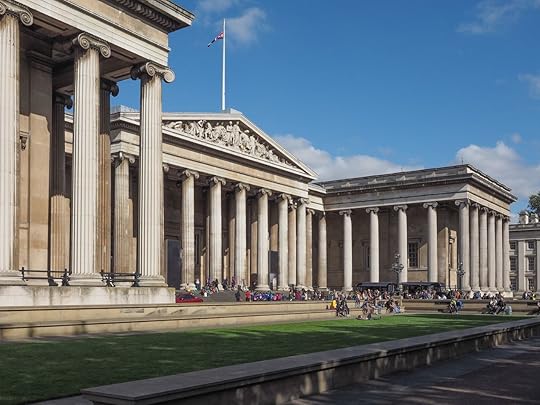
Photo: Claudio Divizia/Shutterstock
British Museum: Desire, love, identity: LGBTQ histories trailThe British Museum has created an LGBTQ Histories Trail that charts queer desire, love, and identity across the entire collection. This program helps LGBTQ+ people connect with queer history, going back to antiquity and earlier. Visitors can view, for example, an ancient Greek vase depicting the famous lesbian poet, Sappho, and better understand her impact on the classical world. History buffs, both gay and straight, will enjoy. Entry to the British Museum is free.
Address: Great Russell St, Bloomsbury
Museum of London: Hidden Pride: London’s LGBT historyThe Museum of London has a vast collection of archives documenting the city’s LGBTQ+ past. It also hosts queer cultural events throughout the year, especially during Pride month.
Address: 150 London Wall
London Gay Men’s Chorus
Photo: London Gay Men’s Chorus/Facebook
Britain’s biggest (and gayest) boy band performs several times per year around London. With various annual events, you can see for yourself why the London Gay Men’s Chorus has a world-famous reputation.
Where to stay in London
Photo: Airbnb

Photo: Airbnb

Photo: Airbnb
From luxury hotels to modern hostels, there are so many lodging options in the capital. But as the city is so spread out, your best bet when looking for accommodation is to decide what neighborhood you want to base yourself in. Booking an Airbnb is a solid idea because you can have more of a local experience in gay London. Check out Matador’s comprehensive article on the best Airbnbs in London’s trendiest neighborhoods for a good guide of trusted rentals.
LGBTQ+ day trips from LondonBrighton
Photo: VisitBritain
No gay London guide is complete without at least mentioning Brighton. On the sandy shores of the English Channel, Brighton is to London, as Fire Island is to New York: It’s where the gays go when the sun comes out. St. James Street in the Kemp Town neighborhood is where you’ll find most of the action. LGBTQ+ venues blanket this area, but virtually every place around here is gay-friendly at the very least. Less than one hour from London by train, Brighton is an easy day trip or weekend getaway. Read more on how to spend your time there in our ultimate LGBTQ guide to Brighton. 
Matador Network's Blog
- Matador Network's profile
- 6 followers



